#Insulated Roof Cladding
Explore tagged Tumblr posts
Text
Smith Structure | Elevating Structural Support Systems
Smith Structure introduces jack beams, essential for construction, ensuring reliable support for floors, roofs, and load-bearing elements.
Visit :

0 notes
Text
#westville group#cavity wall insulation#westville#home insulation#cladding#external insulation#roof insulation#ventilated home
0 notes
Text
Trusted ROCKWOOL Cladding Insulation by CSS CLADDING LTD
CSS CLADDING LTD offers reliable ROCKWOOL cladding insulation solutions designed for strong thermal, fire, and sound performance. Ideal for walls, roofs, and floors, products like the ROCKWOOL rainscreen duo slab, Timber Frame Slab, and Steel Frame Slab are perfect for new builds and extensions. They are lightweight, easy to install, and rated Euroclass A1 for fire safety. Suitable for ventilated façades, metal systems, and cavity fire stopping, ROCKWOOL insulation is a smart choice for long-lasting protection.
#ROCKWOOL Cladding#CSS CLADDING LTD#Insulation Panels#Fire Safety#Acoustic Insulation#Rainscreen Duo Slab#Wall and Roof Insulation#Timber Frame#Steel Frame
0 notes
Text

Aluminum composite panels (ACM) are a type of composite material made from two thin sheets of aluminum bonded to a polyethylene core. They are lightweight, durable, and easy to maintain. ACM panels are often used in exterior applications, such as cladding, roofing, and signage. Here are some of the benefits of using ACM panels: Lightweight. ACM panels are lightweight, which makes them easy to install and maintain. Durable. ACM panels are durable and can withstand the elements. Easy to maintain. ACM panels are easy to maintain and do not require regular cleaning or painting. Versatile. ACM panels can be used in a variety of applications, including cladding, roofing, signage, and insulation. Cost-effective. ACM panels are a cost-effective option for a variety of applications. If you are looking for a material for an exterior application, ACM panels are a good option. They are lightweight, durable, easy to maintain, and versatile.
Please call or fill out our online form to request an estimate or ask general questions about our services. We are excited to serve you!
(718) 517-9178
https://www.skywindowsnj.com/
#aluminumcompositepanels#acppanels#compositepanels#aluminiumcompositepanels#exteriorpanels#cladding#roofing#signage#insulation#cost-effective#lightweight#contractor#brooklyn windows#window installation nyc#design#nyc windows#Aluminum composite panels
0 notes
Text
instagram
Discover the best in thermal insulated roofing sheets with METAhybrid® roofing sheets – lightweight, eco-friendly, and noise-reducing. Stay cool, save big, and enhance your space. Visit us at www.metahybrid.in or contact us at 8550995556 | [email protected]. . . . . #thermalinsulatedroofingsheet #roof #sheet #insulatedroof #soundproofing #soundproof #heatinsulation #architecture #interiordesign #insulatedroofing #insulatedpanels #insulatedpanel #thermalinsulation #metahybrid #roofinsulation #geometric #steels
#heat insulated roof sheets#heat insulation for metal roof#insulated cladding sheets#insulated metal sheet#insulated profile sheet#insulated steel sheets#metal sheet with insulation#thermal insulated roofing sheets#thermal insulation metal sheet#thermal roof sheets#insulated thermal roofing#Colour coated thermal insulated roofing sheets#heat insulated sheet for roof#Aluminum Thermal insulated roofing sheets#Instagram
0 notes
Text

A BOY'S FIRST PEST
Kaz Brekker x Reader
Summary - Kaz Brekker thinks Per Haskell's daughter is a (very lovely) pest
Warnings - fem!reader, traumatraumatrauma, the woes of troubled youth, light mentions of blood and death, these bitches trauma bonded yo, could deviate some from canon, based more on book!kaz than show, NOT EDITED WE DIE LIKE MEN
Word Count - 2.0k
!MINORS DNI!
// masterlist // send me your thoughts // comments & reblogs appreciated! //





Everyone knows Kaz Brekker put his own money into fixing up the Slat.
He hired men to patch the leaky roof (though it still drips during a heavy rain) and put proper insulation in the walls (which keeps the house warm enough, even if it does nothing to muffle the noise of its occupants). He had all the doors fitted with working knobs (but easily picked locks) and ensured the kitchen was capable of making a warm meal (even if seriously doubted any of the Dregs knew how to cook).
And while he would never admit it aloud, Kaz was also the one who made sure there were always clean linens in every room (albeit the cheapest Ketterdam has to offer) and spare clothes in every closet (sizes ranging from wafer-thin to barrel-chested). In keeping, he also takes it upon himself to keep the bathing room stocked with a steady supply of toiletries (because if someone uses his toothbrush again, he’s going to kill everyone in this place and then himself).
Because of Kaz Brekker, the Slat was more than just a safe place to hole up. It was a haven, the closest thing many of the Dregs had to a home.
But it did, of course, have one enduring problem.
The pests.
Or, namely, the one pest—one that he could never quite exterminate (though the spider privy to the inner-workings of Kaz Brekker’s mind might argue the merit of replacing ‘could never’ with ‘would never’).
Per Haskell’s very annoying (and very lovely) daughter.

In the midst of Ketterdam’s hottest season, you find yourself lying sprawled on your back atop the dark sheets, clad in the skimpiest nightclothes you own: a matching set of black silk shorts and flowy, thin-strapped camisole. The air is thick and near stifling in the attic-bedroom, but you don’t mind it. You prefer being hot to cold, if only because the heavy weight of winter clothes makes you feel trapped, eliciting the urge to crawl straight from your skin.
When the door finally swings open, you eagerly push up onto your elbows.
Kaz doesn’t so much as spare a glance in your direction. He’s got one hand on his cane, the other shoving the door shut behind him as he limps toward his desk, guided by the bright moonlight spilling in from the muggy window.
Your shoulders slump, huffing out a breath. “Seriously? You’re not even gonna greet me?”
With his back turned to you, Kaz removes his hat and places it on the desk. He doesn’t look at you. “You’re in my room.”
“Yeah—so I was actually thinking something more along the lines of hello,” you drone, lips pursed. “Y’know, that thing normal people say when they see their friends.”
“We’re not friends.”
A hand flies to your chest, as if struck by his words. “Um, ouch? Rude. For your sake, I’m gonna pretend I didn’t hear that.”
Kaz tugs off his signature gloves and tosses them next to his hat. “I can always repeat it,” he says, so impassive you can’t tell if it’s a joke.
Knowing Kaz, you’re pretty sure it’s not.
You push up the rest of the way, scooting down to sit cross-legged at the end of his bed. It’s so much nicer than yours—the sheets softer, the mattress plusher, the smell so familiar and warm.
If it were up to you, you’d sleep in here every night.
And most nights, that’s exactly what you do.
“Would it kill you to be nice sometimes?” you ask.
“Not usually, no.” Kaz faces you, his weight leaned back against the desk, his cane propped against it. “But we both know you’re a special case.”
“Is that a compliment?”
“Not at all.”
Your bottom lip juts into a pout. “Has anyone ever told you you’re an asshole?”
Aside from the subtlest lift of his brows, Kaz’s expression remains vague and disinterested. “Regularly,” he deadpans, looking the image of austere melancholy.
Your laugh comes so sudden it sounds like a snort. “I should’ve guessed,” you nod, forever unphased by Kaz’s forbidding attitude.
This is the way things have always been between you. Ever since a surly twelve year old marched head-high into your father’s office to see if the Dregs needed a new grunt, oblivious to the girl beaming up at him from a lonely corner, weaving colorful scraps of thread into bracelets for the friends you’d yet to make.
Kaz Brekker is dark and foreboding while you’re bright and bubbly; he’s rude and standoffish while you’re sweet and flirtatious. Some may liken your relationship to oil and water, but you prefer thinking of it as a carefully crafted balance—a yin and yang sort of thing.
Kaz, on the other hand, would simply say you’re a thorn in his side.
Fortunately for yourself, you’re not an easily offended thorn.
The rickety floorboards creak as Kaz starts around the desk. His bare fingers trail along the varnished edge for support. His limp is always at its worst by this time of night, so you’re not surprised to see the flicker of relief that slips over him when he finally sinks into the chair.
“Have you ever considered that maybe you work too hard?” Your voice teeters on the edge of concern, tracing idle shapes against the sheets with your nails.
His answer is curt, and contradictory to the purple smudges beneath his eyes. “No.”
Fumbling with his cufflinks—simple, unadorned things—Kaz rolls his sleeves up to his elbows. Afterwards, he flips open the thick ledger laid before him, plucking up a pen and dipping it into an awaiting pot of ink.
Kaz keeps track of the Dregs expenses in his head—a skill you’ve always found most impressive, since you can hardly do a simple equation without scratch paper. Still, he keeps the physical record for the sake of having something to point to in case someone’s ever stupid enough to claim Dirtyhands flubbed the numbers.
As he works, boredom quickly becomes a chip on your shoulder.
Your legs unfurl, bare feet stretching toward the floor as you slip off the edge of the bed. Every step is purposeful, traipsing toward him with a look that’s not so unlike a cat readying to toy with its favorite mouse.
“Maybe we should take a holiday,” you suggest, your voice a soft trill.
One part of you expects to be ignored, the other to be shot down.
He lands somewhere in the middle.
“And go where? His eyes remain focused on the ledger, dark brows drawn tight in concentration. You envision numbers flashing before him, adding and subtracting at the steady pass of the nib scratching against parchment.
“I don’t know. Ravka, maybe?”
“Ravka?” It’s like the word tastes sour on his tongue. “Why?”
You stop just short of his desk, an answer instantly rapping at your mind. You quickly replace it with one that’s far less tragic. “I wouldn’t mind seeing Nikolai Lantsov with my own eyes,” you drawl. “Nina says he’s quite the looker, y’know.”
Kaz sits up a little straighter, shoulders pinned with newfound tension.
“Of course he is.” He seems to press the nib down harder, his disinterested tone bordering close to resentful. “He’s a prince—looking pretty is all they’re good for.”
Your head tilts. “Well, he’s actually a king now, so…”
There’s the briefest falter in the smooth motion of his jotting wrist. “I’m not taking you to Ravka so you can seduce the Lantsov bastard.”
“And why not?” You reach for the tip of his cane, still propped against the desk, skimming a finger over the crow’s head. “You think I can’t do it?”
The pen keeps on scratching, accented by the dull hum of the Slat’s perpetual motion—doors slamming, voices cackling. Your ego grows larger for every second Kaz stays silent, your satisfaction settling into a feline smirk.
Simply, yet firmly, Kaz eventually maintains, “We’re not going to Ravka.”
Your exhale is something over dramatic, laden with feigned disappointment as you huff, “Fine!” Kaz never looks up, continuing with the ledger.
Abandoning the crow’s head, you swipe one of Kaz’s abandoned gloves off the desk, fiddling with the smooth leather. Still recovering from their civil war, you imagine Ravka isn’t an ideal travel spot right now, anyway. Not unless someone has a morbid desire to tour the sites where Saints met their often-grisly ends, that is… Besides, for all Nina’s praise of the Lantsov king, you’ve never actually had a thing for blondes.
And yet—
“I really would like to go someday.” Your voice is hardly a whisper. Your other answer—tragic and rapping—crawls up your throat in a hoarse admission, “My mother was Ravkan.”
That persistent scratching finally comes to a sudden halt.
For the first time since he entered the room, Kaz looks up. There’s not a hint of pity in his eyes, though they gleam with solemn understanding. Your lips thin, pressing his glove tight to your chest.
In the winter of your fourteen birthday, you snuck into your father’s office and stole a full bottle of kvas. Dressed in clothes too light for the frigid weather, you sped up the crooked stairs to Kaz’s attic-bedroom, pleading until he begrudgingly agreed to join you on the moonlit roof. For a boy who claimed such an aversion to you, he was always doing things you asked—even if he’d griped the whole time. You both gagged after the first sip of hard liquor. After an hour or so, the full bottle had dwindled to just a drop, your tongues seeming to move with more freedom.
Neither of you had been prepared for the way the carbonated joy in your chests fizzled to something stagnant.
I don’t like being alone, you told him, fiddling with the frayed strings tied around your wrist, the friendship bracelets no one ever wanted. If I’m alone, it means I’m thinking, and if I’m thinking, it means my mother won’t stop dying.
You told him of the endless montage in your head. How at six years old, a walk along the Stave in your favorite winter coat ended with getting crushed beneath the weight of your mother’s last act of devotion, shielded by a body crumpled and crimson, shorn in the crossfire of unexpected gang violence. When you fell silent, Kaz drained the last drop of kvas and told you about a coffee shop near the Exchange. About a sickboat and a boy named Jordie, about a frosty harbor and an impossible swim that left him unable to bear the touch of another’s skin.
When neither of you had any soul left to bear, Kaz chucked the bottle off the roof. You don’t remember hearing it shatter, and maybe it never did. Maybe it hit some hapless pigeon and fractured his skull. Maybe it ceased to exist the moment it went over the edge. The bottle didn’t matter. Not to you. Not when Kaz Brekker reached for your wrist, leather-clad fingers gently tugging the bracelets off your wrist.
Don’t make a thing of this, he told you, stuffing them in his pocket. You’re still a pest.
But it was a thing. A strange, beautiful thing—and both of you knew it.
“Fine.” Kaz’s voice—the rasp of stone on stone—drags you back to the present. He sits the pen down beside the ledger, a strand of black hair swaying with the subtle shake of his head. “We’ll go to Ravka. You’ll seduce some sorry prince and live happily ever after in a gaudy palace. I’ll make my fortune snagging the Lantsov Emerald and use it to hire a proper bookkeeper. Deal?”
Your lips twitch, still hugging his glove to your chest. “King,” you correct him.
His eyes roll, but a flicker of something warm betrays his affection. “Pest,” he calls you, though it doesn’t sound like much of an insult.
“I imagine the Grand Palace has fine exterminators,” you muse.
“Then I suppose your marriage will be short-lived.”
“Will you save me, then?” Your heart leaps with the question, how it slips from your tongue before you can grasp it.
Kaz hesitates. Then—remarkably—smiles.
“Maybe.”


a/n - you know what they say. a bottle of kvas is never just a bottle of kvas, amirite
(☞ ͡° ͜ʖ ͡°)☞
anyways, i was procrastinating an essay and thought "lets write something with a somewhat ambiguous ending!" and voila, a boy's first pest is the product. now everyone say: lainie, go work on your original writing and stop writing so much fan fiction! (but i'm already thinking of a kaz smut drabble so) anyways, comments and reblogs much appreciated, i cry with joy every time someone actively interacts with my work so THANK YOU
#kaz brekker imagine#kaz brekker x reader#shadow and bone imagine#six of crows imagine#shadow and bone fanfic#s&b imagine#kaz brekker x fem!reader#kaz brekker x you#shadow and bone fic#shadow and bone x reader#six of crows x reader#six of crows imagines#crooked kingdom#six of crows#shadow and bone#s&b netflix#kaz brekker#six of crows fanfic#grishaverse imagine#grishaverse#freddy carter imagine#freddy carter
577 notes
·
View notes
Text




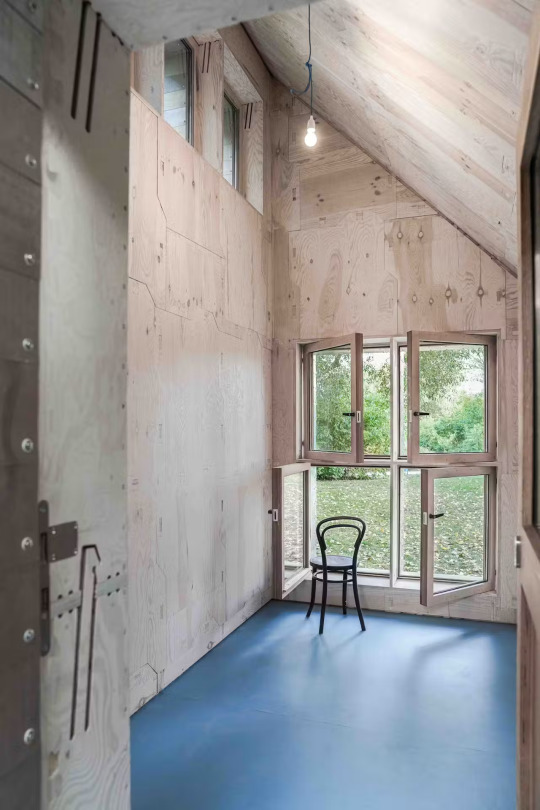


Digital House, Wismar, Germany,
the “Digital House” is a prototypical building entirely digitally designed, fabricated, and assembled without the need for tools. Julian Krüger (Munich University of Applied Sciences) and Benjamin Kemper (Wismar University of Applied Sciences) developed a sustainable, cost-effective building system based on innovative plug-in construction methods.
In a grove not far from the Faculty of Architecture and Design at Wismar University, a small house with a shiny, silvery facade and a steep, west-facing mono-pitch roof stands 6.5 m high on a footprint of 3.3 × 4.9 m. Light enters the spacious interior through a continuous window ribbon and four large windows cutting through the facade made from recycled aluminum sheets.
The house features an inventive wood construction system CNC-milled from 24mm plywood, allowing two people to assemble it quickly without any tools or hardware, such as screws or nails. This flexible system, which allows for disassembly and reuse, strengthens the project's approach to sustainability.
The wooden structure is clad with plywood panels inside and a vapor-permeable wood fibreboard on the outside and insulated with eco-friendly wood fiber.
The "Digital House" rests on six ground screws, enabling quick and traceless disassembly and eliminating the need for concrete or groundwork.
Julian Krüger + Benjamin Kemper
#art#design#architecture#minimal#nature#interior design#retreat#cabin#digital#digital architecture#prototype#sustainability#sustainable architecture#recycling
198 notes
·
View notes
Text
WIP stuff
Been toying over the weekend but not got very far. I could say that the fact this section is slow and barely anything happens is deliberate because Scott is frustrated by the slowness and barely anything happening… yeah let’s go with that!
Anyway some standard bros waiting by sickbed of other bros fluff. Well, kind of fluff. Like that fibreglass roof insulation stuff maybe?
💙💚💙💚💙💚💙💚💙💚💙💚💙💚💙💚
The sedative had been wearing off slowly. Really, really, really slowly.
Agonisingly slowly.
There were two signs - the occasional bumps in heart rate were the easiest to track and John monitored these with his usual precision, occasionally passing a quiet comment as to the length and volume of the spikes.
Scott was more focussed on the other - the tiniest of movements in Virgil’s hands which had been lying limp on top of the covers, and which Scott had gently arranged and rearranged to try to find the most natural position for muscles and ligaments to rest in. He watched and waited and pondered whether he should move his brother’s right thumb a little to the left - was the hand too curled up, or was it meant to be that way? He was aware that there were probably much bigger issues right now but he didn’t want his brother to end up with aches that might hinder his playing or drawing. And this… this he could do something about.
He sighed and adjusted the thumb minutely, then pretended he hadn’t noticed John pretending not to notice.
It occurred to him that he never really saw Virgil’s hands at rest. His brother was always either tinkering with something, gesticulating expressively as he conversed, or tapping out a rhythm on the biceps of his folded arms… his denim clad thighs… or whatever surface happened to be nearby. Scott’s shoulder was not exempt as a surface but he never mentioned it for fear Virgil would become self-conscious and less comfortable to casually throw his arm around his big brother. And big brother treasured every one of those moments.
A stronger twitch of the fingers was accompanied by the slightest hint of tension in Virgil’s jaw. Scott reached out and placed his hand over one of his brother’s, seeking connection with that flicker of life… then picked up his brother’s hand and held it close to his chest. He found himself leaning forwards so that he could feel his brothers’ breath on his cheek, seeking reassurance that Virgil was in there and would come back to him.
This meant, of course, that Scott’s eardrum was in prime exploding distance when Virgil yelled his name.
💚💙💚💙💚💙💚💙💚💙💚💙💚💙💚💙
#thunderbirds are go#thunderbirds#thunderbirds fanfiction#scott tracy#virgil tracy#idontknowreallywhy fanfic#WIP whenever#earth and sky
27 notes
·
View notes
Text
At Above & Beyond Windows, we’re proud to be Stockton-on-Tees' trusted specialists in high-quality windows, doors, conservatories, and rooflines. With years of experience and a reputation for going the extra mile, we deliver professional home improvement solutions that are built to last and designed to impress.
Whether you're looking to upgrade your home’s energy efficiency, boost kerb appeal, or add valuable living space, our expert team is here to help you every step of the way. From the initial consultation to final installation, we’re committed to providing a seamless, stress-free experience — and results that truly go above and beyond.
Windows We supply and install a wide range of double and triple-glazed windows in styles to suit every home. From sleek modern designs to traditional finishes, our windows combine stunning aesthetics with advanced energy performance and security. Each unit is custom-measured and professionally fitted for optimal performance.
Doors Transform the entrance to your home with our collection of composite, uPVC, French, patio, and bi-fold doors. Our doors don’t just look great — they’re designed for durability, insulation, and security. With a variety of colours and finishes available, we offer the perfect door to complement your property’s style.
Conservatories Dreaming of extra living space? Our custom-built conservatories offer a beautiful way to extend your home and enjoy your garden year-round. Whether you want a classic Edwardian look or a sleek modern orangery, we create light-filled spaces tailored to your needs, complete with high-performance glazing and roof systems.
Rooflines Protect and enhance your home with our professional roofline services, including fascias, soffits, guttering, and cladding. We use durable, low-maintenance materials to ensure your roofline looks great and functions perfectly — year after year, in all weather conditions.
Why Choose Us? ● Fully insured & certified installers
● Competitive pricing with no hidden costs
● High-grade materials with long warranties
● Exceptional local reputation and customer reviews
Based in Stockton-on-Tees and serving the surrounding areas, Above & Beyond Windows is your local choice for quality, value, and service that truly lives up to our name.
Website: https://g.co/kgs/ar8uVCC
Address: Unit 9 Marston Rd, Stockton-on-Tees, TS18 2PN
Phone Number: 01642 989915
Contact Email ID: [email protected]
Business Hours: Mon - Fri : 08:00 am – 05:00pm Sat : 09 :00am – 03:30pm Sun : Closed
2 notes
·
View notes
Text

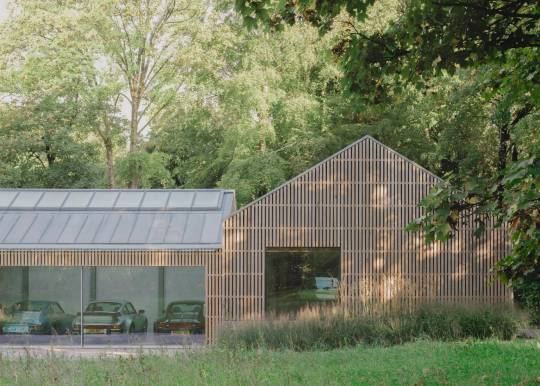


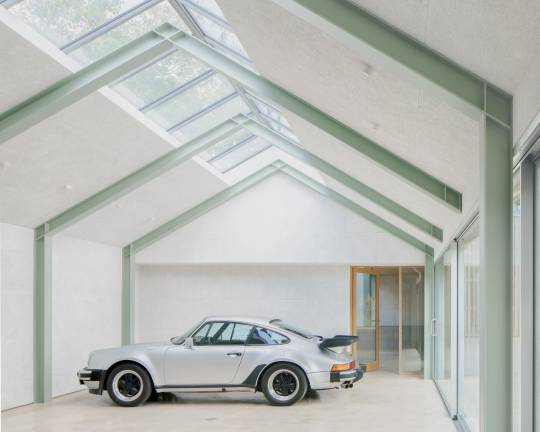


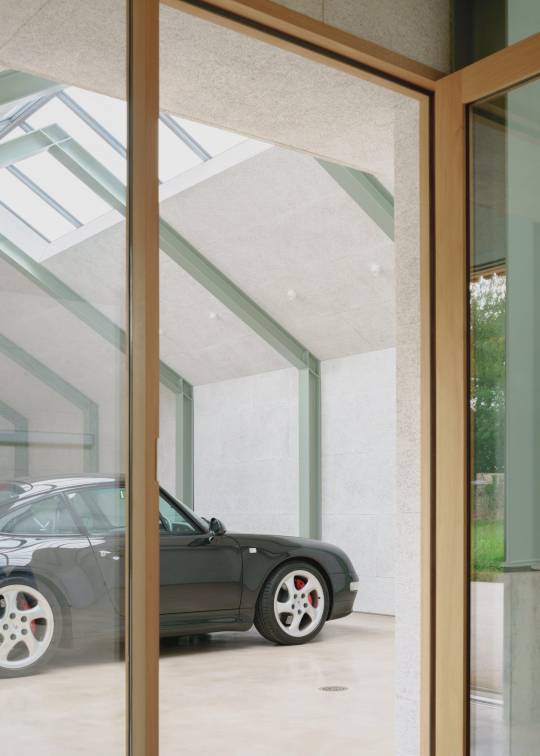
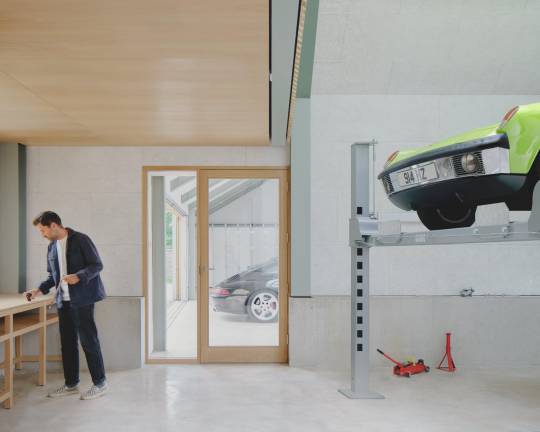



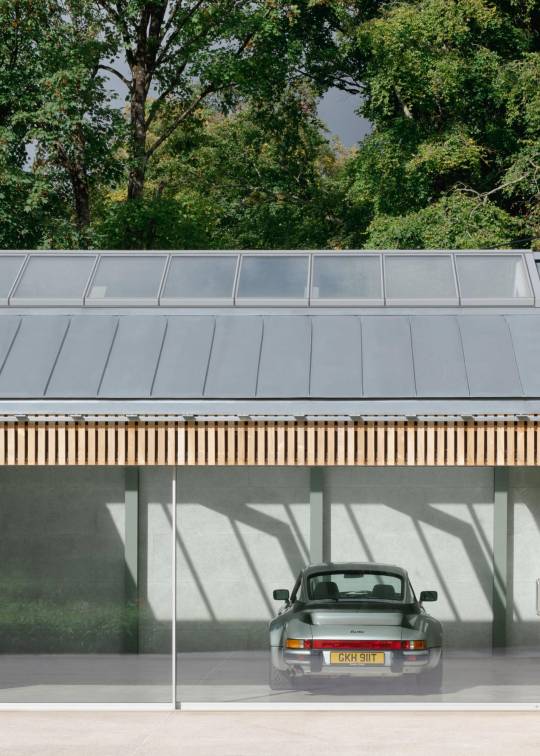
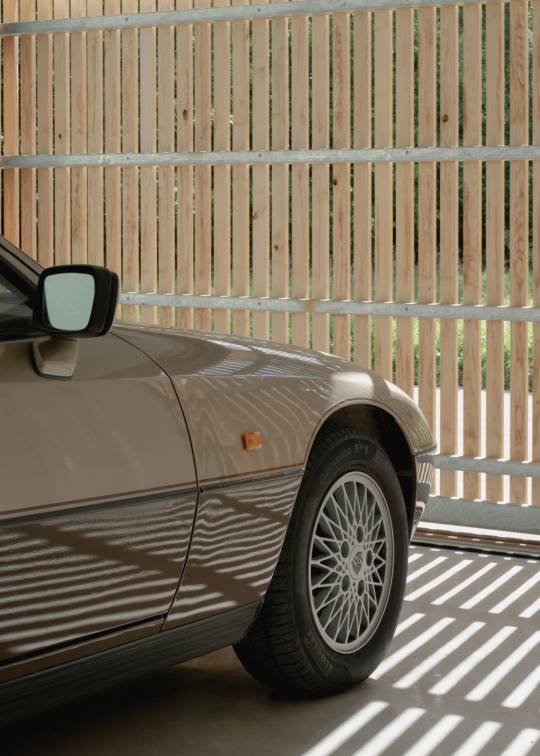


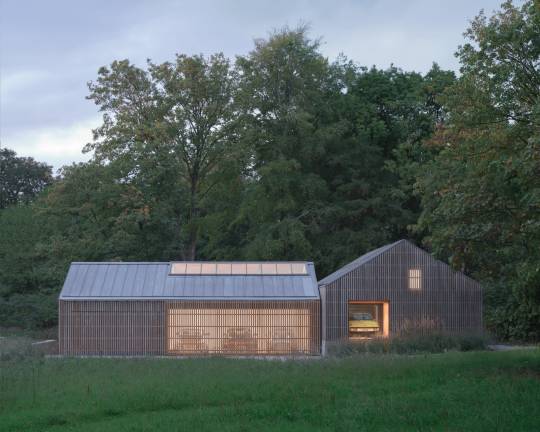
Autobarn by Bindloss Dawes
The Autobarn is the realisation of our client's long-term dream to house his collection of classic German cars. The project is composed of two volumes: a clean, five-bay garage for everyday use and a taller workshop for repairs and future restoration projects.
Beyond satisfying this initial use, the project ambition was to create a flexible, 'long-life, loose-fit' building that could be used for a range of different uses. Currently it doubles up as event space, however the ambition is that the Autobarn could one day become a low-energy house.
Located on the outskirts of a small Somerset village, the project is set within the grounds of an eighteenth-century Grade 2 listed house. It replaces several haphazard outbuildings and consolidates their amenity into an elegant architectural proposal, nestled within a glade of mature trees.
The project's design references the language of neighbouring agricultural barns. As a practice we are interested in reassessing the rural vernacular, both for its contextual appropriateness and its lessons in low-cost, pragmatic design. As such, the Autobarn re-interprets simple forms and methods of construction, adapting more temporary, rudimentary methods into a robust and elegant paradigm for low-cost, rural architecture. Composed of a concrete base and steel framed structure, intermittent timber cladding and zinc metal roof, the Autobarn adapts barn typologies with varying levels of refinement. Consideration was also given to its weathering, with the natural zinc roof dulling to complement the silver patination of the sweet chestnut cladding.
Like many barns, permeability to light and air is controlled through a series of movable layers. First experienced as a closed solid mass, the barn walls open up via a number of doors, including an heroic 7m sliding timber screen. The intermittent timber slats of the screens create internal dappled light during the day, which is reversed at night as interior lighting illuminates the surrounding landscape. Internally the steel structure is expressed in an array of simple portal frames, with sustainably-sourced wood-fibre acoustic board forming internal wall and ceiling. The garage space is calm and gallery-like, while the workshop space presents a tougher, taller workshop, surrounded with concrete wainscotting and designed to accommodate a car lift.
The building's 'long-life/loose-fit' ambitions have meant that the insulation and energy performance exceed residential standards. Although thermostats are currently turned down for its current use, the building includes underfloor heating powered by an Air Source Heat Pump, as well as additional first fix services hidden behind the internal wall paneling for future conversion.
Construction started in November 2020 and was completed at the end of 2021, with the project effected by the global pandemic and building material inflation. Despite these challenges, and the inclusion of some one-off expensive items (such as the electric garage doors), the Autobarn was built for under £2,300 / m2. In tandem with high energy performance and the use of natural materials, it combines our studio's goal to combine beauty, affordability, and sustainability.
Design: Bindloss Dawes Location: Frome, United Kingdom Area: 165 m² Year: 2022 Photography: Building Narratives
#architecture#gable roofs#garages#barns#british barns#british garages#united kingdom#bindloss dawes#building narratives#interiors
34 notes
·
View notes
Text
SSIPL offers custom insulated roof and wall cladding with low thermal conductivity, designed to reduce heating and cooling costs.

0 notes
Text
#westville group#cavity wall insulation#cladding#westville#home insulation#roof insulation#ventilated home#external insulation
0 notes
Text
A large fire was witnessed by residents of Liverpool Student Lettings accommodation in the early hours on January 27 2024. #LiverpoolEcho


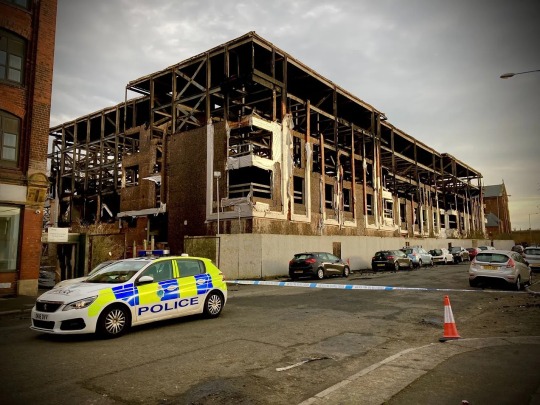

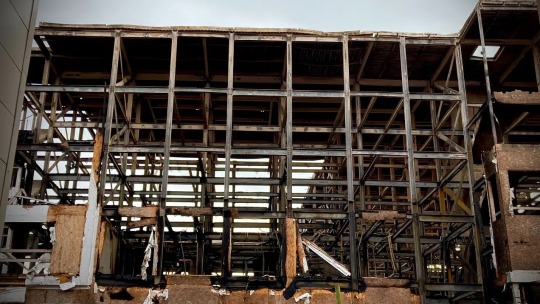
Village of the damned: Inside the Fox Street fire
Special investigation: For years, Matt O'Donoghue was told about major problems at a controversial development in Everton. Then the dire predictions came true. By Matt O’Donoghue.
“Block D is an inferno right now”, the first message reads. “Look what’s been torched.” More follow. “Not sure how other blocks are faring, they’ve been evacuated.” Some have video or photos attached. “Seen this. I feel sick.” One simply reads: “Fox Street’s final chapter.”
Block D at the stalled residential development of Fox Street Village sits on the edge of Everton. It is ablaze, and a lot of people want me to know. As the firefighters battle to hold back the flames that threaten to leap from block to block, frantic calls, dramatic videos, and heartbreaking messages light up my phone screen. Many of those getting in touch are people I met over the past five years I’ve been reporting on the sorry saga of Fox Street Village. They’re all saying the same thing: “It was only a matter of time.”
“Something like this had to happen,” says Chris Burridge, who owns one of the Fox Street Village apartments as he surveys the damage. It’s Sunday, January 28th and the day after the fire. Steel girders are bent and buckled like roller coaster tracks; the metal cools and creaks, and loose material flaps in the wind. “There’s been no decent perimeter fence for some time, even though we’ve been reporting incidents. We were lucky Block B didn’t go up. The flames and heat were ferocious. Mersey Fire saved those buildings.”
Lucky indeed. Fox Street Village was originally intended to be a 400 apartment complex spread across four blocks that were to be four or five stories tall. But Block D was never completed and has remained an unfinished shell for the past five years. The rest of the site, on the other hand, is home to a number of residents. Had the fire spread there, it would have been catastrophic. Letting agents are on-site to support tenants and help with the clean up, while insurance brokers and risk assessors mill about around them. Lifts, heating, and water are soon back on. Black debris litters the ground and the flat roofs of the adjacent blocks, while clumps of burnt insulation and wood continue to drift from above.
A team from Residence 365, the company that manages the Village’s interior communal areas, is helping to get residents back into their homes. “Unfortunately, as the fire started to take hold, many residents in Block A failed to evacuate,” says Carolyn Delaney, Residence 365’s managing director. “Police had to force their way into every apartment to make sure that building was clear and everyone was safe. Those doors and frames will have to be repaired.”
Outside, Block B’s walls and windows are warped from where it faced the fire. The cladding is buckled and wavy, like bad icing on an overbaked cake. Most of the glass is cracked and broken, and window frames have bowed out of shape. The fire breaks under the cladding will have activated and expanded. There will need to be a lot of work to put things right.
“The grounds and estate management company are nowhere”, says an exasperated Burridge. The last he was told, a company called Xenia Estates Limited were responsible for looking after the outside areas. “It’s outrageous. They’ve sent nobody down here to help or make things safe.”
Kevin Robertson-Hale is a local campaigner who set up the action group Everton Together. He was shopping at the ASDA on the Breck Road when he first saw the black clouds rising above his community. He knew straight away what was likely to be burning. “It’s just a miracle that nobody’s been hurt,” he says. Although Block D was not a finished building, homeless people have been sleeping there and using it as a shelter. “The way the place went up, someone asleep would never have got out.” Kevin is horrified by what has happened, but certainly not surprised. “We’ve been saying for years that something was going to happen. Either someone was going to fall off and break their neck, or it was going to go up in flames.”
Beneath the debris and behind the spectacular videos, the plumes of smoke billowing out and up from the bare bones of blazing Block D, are hundreds of stories of loss and despair. To properly understand what went wrong at Fox Street Village, to learn why things must be fixed, we have to understand why they were broken in the first place.
Between 1971 and 1991, Everton’s population dropped by 60% as the area’s fortunes and prospects charted exactly the decline of the British Empire. As Liverpool’s docks fell silent, the huge warehouses and the factories like Tate and Lyle and British American Tobacco were closed. Thousands of jobs disappeared and the communities that once relied upon those goods shipped from all corners of the Empire ceased to exist. An urgent need to improve the area’s housing conditions, the crumbling Victorian tenements, led to slum clearance and demolition on a massive scale. Those once solid communities were broken up with families moved out and housed in places like Kirby, Runcorn and Skelmersdale. It was the perfect storm; shops closed, tower blocks were pulled down and the city’s terminal decline was hastened by Margaret Thatcher’s vicious attempts to starve the upstart council controlled by Hatton’s Militant Tendency into surrender.
Fox Street Village followed the same controversial funding model that has dogged similar schemes across the city, known as ‘fractional sales’. Buyers — many based overseas — are enticed with the promise of a good rent and a solid investment in return for paying a large part of the sale price upfront. But as countless investors at other stalled sites in Liverpool have discovered to their detriment, there’s little or no protection should things go wrong.
When Fox Street Village Limited collapsed into administration, in 2019, it owed creditors £10 million and the city council nearly £700,000. The council told us that an invoice for over half a million pounds remains unpaid but that the building’s new owners will have to pick up that tab. Meanwhile, £6 million that investors had paid out for Block D was instead spent on a new fifth building the developers had added to their scheme. A search of records show creditors who had paid for apartments in Block D came from Birkenhead to Beijing and all points in between. With no money left to complete the job, and no cash to settle their bills, the steel frame and internal walls made of wood have remained open to the elements. The freehold to the site was sold to Manchester-based property investment company SGL1 Limited in 2020 for a reported £1.6 million. The site was split and a separate company run by the same two directors as SGL1 but called SGL3, took over the unfinished Block D. A series of complex court cases followed as buyers battled to gain control and finish the scheme. By 2021, the architect’s original drawings for Block D had been rebranded as “Park View” to be marketed at a new group of buyers. A one bed studio in the unfinished wood and steel shell was being advertised for £85,000. The Post is unsure how many people bought into this new scheme or whether their money is protected.
“I bought a three-bedroom apartment that cost £135,000, which was a really good deal. With hindsight, almost too good to be true. I’ve been firefighting one problem after another since day one.” November 8th, 2023 and I am rattling along the M62 with Chris Burridge. “It doesn’t look that good,” Chris says with detached stoicism and monumental understatement as Fox Street Village Block D comes into view. “It would be funny, if it wasn’t so costly and dangerous.” Chris is one of the apartment owners who have been battling over an £80,000 bill to install a transformer that would safely reconnect their electricity to the grid. The builders left a hot-wired connection into the mains, which Chris says the buyers only found out about after they’d secured the right to manage some of the site. It was just the latest in a long line of hidden surprises that have revealed themselves over the five years since tenants moved in. “The biggest block, Block D, is just a shell that should have been finished years ago,” Chris tells me as we pull up alongside what looks like a building entirely made of wood and wrapped in tin foil. “There should have been one large, shared entrance area, an underground car park for 170 vehicles, shops, a cinema room with communal laundry, and a bike store. All of those amenities were what made this site so attractive.”
Chris pauses to re-imagine what could have been, before reality kicks back in. “None of that exists. What we’ve actually got are great apartments next to the rat-infested fire trap of a mess that is Block D.”
By Matt O’Donoghue
“Block D is an inferno right now”, the first message reads. “Look what’s been torched.” More follow. “Not sure how other blocks are faring, they’ve been evacuated.” Some have video or photos attached. “Seen this. I feel sick.” One simply reads: “Fox Street’s final chapter.”
Block D at the stalled residential development of Fox Street Village sits on the edge of Everton. It is ablaze, and a lot of people want me to know. As the firefighters battle to hold back the flames that threaten to leap from block to block, frantic calls, dramatic videos, and heartbreaking messages light up my phone screen. Many of those getting in touch are people I met over the past five years I’ve been reporting on the sorry saga of Fox Street Village. They’re all saying the same thing: “It was only a matter of time.”
Chris Burridge on Fox Street. Photo: Matt O’Donoghue.
“Something like this had to happen,” says Chris Burridge, who owns one of the Fox Street Village apartments as he surveys the damage. It’s Sunday, January 28th and the day after the fire. Steel girders are bent and buckled like roller coaster tracks; the metal cools and creaks, and loose material flaps in the wind. “There’s been no decent perimeter fence for some time, even though we’ve been reporting incidents. We were lucky Block B didn’t go up. The flames and heat were ferocious. Mersey Fire saved those buildings.”
Lucky indeed. Fox Street Village was originally intended to be a 400 apartment complex spread across four blocks that were to be four or five stories tall. But Block D was never completed and has remained an unfinished shell for the past five years. The rest of the site, on the other hand, is home to a number of residents. Had the fire spread there, it would have been catastrophic. Letting agents are on-site to support tenants and help with the clean up, while insurance brokers and risk assessors mill about around them. Lifts, heating, and water are soon back on. Black debris litters the ground and the flat roofs of the adjacent blocks, while clumps of burnt insulation and wood continue to drift from above.
A team from Residence 365, the company that manages the Village’s interior communal areas, is helping to get residents back into their homes. “Unfortunately, as the fire started to take hold, many residents in Block A failed to evacuate,” says Carolyn Delaney, Residence 365’s managing director. “Police had to force their way into every apartment to make sure that building was clear and everyone was safe. Those doors and frames will have to be repaired.”
Outside, Block B’s walls and windows are warped from where it faced the fire. The cladding is buckled and wavy, like bad icing on an overbaked cake. Most of the glass is cracked and broken, and window frames have bowed out of shape. The fire breaks under the cladding will have activated and expanded. There will need to be a lot of work to put things right.
“The grounds and estate management company are nowhere”, says an exasperated Burridge. The last he was told, a company called Xenia Estates Limited were responsible for looking after the outside areas. “It’s outrageous. They’ve sent nobody down here to help or make things safe.”
Subscribe
Kevin Robertson-Hale is a local campaigner who set up the action group Everton Together. He was shopping at the ASDA on the Breck Road when he first saw the black clouds rising above his community. He knew straight away what was likely to be burning. “It’s just a miracle that nobody’s been hurt,” he says. Although Block D was not a finished building, homeless people have been sleeping there and using it as a shelter. “The way the place went up, someone asleep would never have got out.” Kevin is horrified by what has happened, but certainly not surprised. “We’ve been saying for years that something was going to happen. Either someone was going to fall off and break their neck, or it was going to go up in flames.”
Beneath the debris and behind the spectacular videos, the plumes of smoke billowing out and up from the bare bones of blazing Block D, are hundreds of stories of loss and despair. To properly understand what went wrong at Fox Street Village, to learn why things must be fixed, we have to understand why they were broken in the first place.
The building on Fox Street. Photo: Chris Burridge
Between 1971 and 1991, Everton’s population dropped by 60% as the area’s fortunes and prospects charted exactly the decline of the British Empire. As Liverpool’s docks fell silent, the huge warehouses and the factories like Tate and Lyle and British American Tobacco were closed. Thousands of jobs disappeared and the communities that once relied upon those goods shipped from all corners of the Empire ceased to exist. An urgent need to improve the area’s housing conditions, the crumbling Victorian tenements, led to slum clearance and demolition on a massive scale. Those once solid communities were broken up with families moved out and housed in places like Kirby, Runcorn and Skelmersdale. It was the perfect storm; shops closed, tower blocks were pulled down and the city’s terminal decline was hastened by Margaret Thatcher’s vicious attempts to starve the upstart council controlled by Hatton’s Militant Tendency into surrender.
Stand on the edge of Fox Street today and look towards the gleaming glass skyscrapers and modern penthouses and it’s obvious, the regeneration that has breathed new life into other parts of Liverpool in recent years seems to run out of steam as it creeps towards this area’s streets. According to the last census, Everton West — where Fox Street Village sits — has the third highest numbers of children on free school meals. This neighbourhood has some of the poorest health indicators, including the lowest life expectancy, across the whole of the city.
As Liverpool’s reputation grew as a great place to study, the last decade has seen residential housing for the influx of students become the city’s short-term planning solution and a way to kickstart Everton’s economy.
Fox Street Village followed the same controversial funding model that has dogged similar schemes across the city, known as ‘fractional sales’. Buyers — many based overseas — are enticed with the promise of a good rent and a solid investment in return for paying a large part of the sale price upfront. But as countless investors at other stalled sites in Liverpool have discovered to their detriment, there’s little or no protection should things go wrong.
When Fox Street Village Limited collapsed into administration, in 2019, it owed creditors £10 million and the city council nearly £700,000. The council told us that an invoice for over half a million pounds remains unpaid but that the building’s new owners will have to pick up that tab. Meanwhile, £6 million that investors had paid out for Block D was instead spent on a new fifth building the developers had added to their scheme. A search of records show creditors who had paid for apartments in Block D came from Birkenhead to Beijing and all points in between. With no money left to complete the job, and no cash to settle their bills, the steel frame and internal walls made of wood have remained open to the elements. The freehold to the site was sold to Manchester-based property investment company SGL1 Limited in 2020 for a reported £1.6 million. The site was split and a separate company run by the same two directors as SGL1 but called SGL3, took over the unfinished Block D. A series of complex court cases followed as buyers battled to gain control and finish the scheme. By 2021, the architect’s original drawings for Block D had been rebranded as “Park View” to be marketed at a new group of buyers. A one bed studio in the unfinished wood and steel shell was being advertised for £85,000. The Post is unsure how many people bought into this new scheme or whether their money is protected.
“I bought a three-bedroom apartment that cost £135,000, which was a really good deal. With hindsight, almost too good to be true. I’ve been firefighting one problem after another since day one.” November 8th, 2023 and I am rattling along the M62 with Chris Burridge. “It doesn’t look that good,” Chris says with detached stoicism and monumental understatement as Fox Street Village Block D comes into view. “It would be funny, if it wasn’t so costly and dangerous.” Chris is one of the apartment owners who have been battling over an £80,000 bill to install a transformer that would safely reconnect their electricity to the grid. The builders left a hot-wired connection into the mains, which Chris says the buyers only found out about after they’d secured the right to manage some of the site. It was just the latest in a long line of hidden surprises that have revealed themselves over the five years since tenants moved in. “The biggest block, Block D, is just a shell that should have been finished years ago,” Chris tells me as we pull up alongside what looks like a building entirely made of wood and wrapped in tin foil. “There should have been one large, shared entrance area, an underground car park for 170 vehicles, shops, a cinema room with communal laundry, and a bike store. All of those amenities were what made this site so attractive.”
Chris pauses to re-imagine what could have been, before reality kicks back in. “None of that exists. What we’ve actually got are great apartments next to the rat-infested fire trap of a mess that is Block D.”
Residents in this area have been complaining to me about the rats for as long as I’ve been investigating Fox Street Village. Back in April 2019, I broke my first story on the slow-motion car crash that has taken place here — months of work as part of an ongoing investigation for ITV’s Granada Reports. Back then, tenant Ross Lowey told me on camera: “We don’t feel safe. Every time we come back round that corner, we expect to see flames coming out of it.” He was far from alone in his unhappy prophecy.
Six months before that first ITV News report, in November 2018, I had been on a separate investigation into how developers duck out of paying the millions they owed to their cash-strapped council. It suddenly took an unexpected twist. While I ploughed through a mountain of conflicting planning documents that link to this case, a buyer tipped me off that their building was about to be the first on Merseyside to be shut down and issued with a Prohibition Notice. It was the last-ditch resort for a city council that had run out of ideas on how to make this site safe. “Serious construction issues will contribute to the spread of fire,” the Prohibition Notice reads. “Fire will spread quickly and possibly unnoticed.”
Put simply, the problems that the buyers had uncovered at their completed flats were so severe that they put lives at risk. While Block D remained unfinished, three of the four blocks that people had already moved into were so dangerous that everyone would be forced to move out — immediately. Judge Lloyd would later brand the project “disgraceful” as she fined the developers £3,120 for breaching planning conditions. She expressed sympathy for the residents and investors who had been affected. Planning inspectors said the development was “poorly finished” and failed to meet standards. Those problems have cost hundreds of thousands of pounds to put right.
3
By Matt O’Donoghue
“Block D is an inferno right now”, the first message reads. “Look what’s been torched.” More follow. “Not sure how other blocks are faring, they’ve been evacuated.” Some have video or photos attached. “Seen this. I feel sick.” One simply reads: “Fox Street’s final chapter.”
Block D at the stalled residential development of Fox Street Village sits on the edge of Everton. It is ablaze, and a lot of people want me to know. As the firefighters battle to hold back the flames that threaten to leap from block to block, frantic calls, dramatic videos, and heartbreaking messages light up my phone screen. Many of those getting in touch are people I met over the past five years I’ve been reporting on the sorry saga of Fox Street Village. They’re all saying the same thing: “It was only a matter of time.”
Chris Burridge on Fox Street. Photo: Matt O’Donoghue.
“Something like this had to happen,” says Chris Burridge, who owns one of the Fox Street Village apartments as he surveys the damage. It’s Sunday, January 28th and the day after the fire. Steel girders are bent and buckled like roller coaster tracks; the metal cools and creaks, and loose material flaps in the wind. “There’s been no decent perimeter fence for some time, even though we’ve been reporting incidents. We were lucky Block B didn’t go up. The flames and heat were ferocious. Mersey Fire saved those buildings.”
Lucky indeed. Fox Street Village was originally intended to be a 400 apartment complex spread across four blocks that were to be four or five stories tall. But Block D was never completed and has remained an unfinished shell for the past five years. The rest of the site, on the other hand, is home to a number of residents. Had the fire spread there, it would have been catastrophic. Letting agents are on-site to support tenants and help with the clean up, while insurance brokers and risk assessors mill about around them. Lifts, heating, and water are soon back on. Black debris litters the ground and the flat roofs of the adjacent blocks, while clumps of burnt insulation and wood continue to drift from above.
A team from Residence 365, the company that manages the Village’s interior communal areas, is helping to get residents back into their homes. “Unfortunately, as the fire started to take hold, many residents in Block A failed to evacuate,” says Carolyn Delaney, Residence 365’s managing director. “Police had to force their way into every apartment to make sure that building was clear and everyone was safe. Those doors and frames will have to be repaired.”
Outside, Block B’s walls and windows are warped from where it faced the fire. The cladding is buckled and wavy, like bad icing on an overbaked cake. Most of the glass is cracked and broken, and window frames have bowed out of shape. The fire breaks under the cladding will have activated and expanded. There will need to be a lot of work to put things right.
“The grounds and estate management company are nowhere”, says an exasperated Burridge. The last he was told, a company called Xenia Estates Limited were responsible for looking after the outside areas. “It’s outrageous. They’ve sent nobody down here to help or make things safe.”
Subscribe
Kevin Robertson-Hale is a local campaigner who set up the action group Everton Together. He was shopping at the ASDA on the Breck Road when he first saw the black clouds rising above his community. He knew straight away what was likely to be burning. “It’s just a miracle that nobody’s been hurt,” he says. Although Block D was not a finished building, homeless people have been sleeping there and using it as a shelter. “The way the place went up, someone asleep would never have got out.” Kevin is horrified by what has happened, but certainly not surprised. “We’ve been saying for years that something was going to happen. Either someone was going to fall off and break their neck, or it was going to go up in flames.”
Beneath the debris and behind the spectacular videos, the plumes of smoke billowing out and up from the bare bones of blazing Block D, are hundreds of stories of loss and despair. To properly understand what went wrong at Fox Street Village, to learn why things must be fixed, we have to understand why they were broken in the first place.
The building on Fox Street. Photo: Chris Burridge
Between 1971 and 1991, Everton’s population dropped by 60% as the area’s fortunes and prospects charted exactly the decline of the British Empire. As Liverpool’s docks fell silent, the huge warehouses and the factories like Tate and Lyle and British American Tobacco were closed. Thousands of jobs disappeared and the communities that once relied upon those goods shipped from all corners of the Empire ceased to exist. An urgent need to improve the area’s housing conditions, the crumbling Victorian tenements, led to slum clearance and demolition on a massive scale. Those once solid communities were broken up with families moved out and housed in places like Kirby, Runcorn and Skelmersdale. It was the perfect storm; shops closed, tower blocks were pulled down and the city’s terminal decline was hastened by Margaret Thatcher’s vicious attempts to starve the upstart council controlled by Hatton’s Militant Tendency into surrender.
Stand on the edge of Fox Street today and look towards the gleaming glass skyscrapers and modern penthouses and it’s obvious, the regeneration that has breathed new life into other parts of Liverpool in recent years seems to run out of steam as it creeps towards this area’s streets. According to the last census, Everton West — where Fox Street Village sits — has the third highest numbers of children on free school meals. This neighbourhood has some of the poorest health indicators, including the lowest life expectancy, across the whole of the city.
As Liverpool’s reputation grew as a great place to study, the last decade has seen residential housing for the influx of students become the city’s short-term planning solution and a way to kickstart Everton’s economy.
Fox Street Village followed the same controversial funding model that has dogged similar schemes across the city, known as ‘fractional sales’. Buyers — many based overseas — are enticed with the promise of a good rent and a solid investment in return for paying a large part of the sale price upfront. But as countless investors at other stalled sites in Liverpool have discovered to their detriment, there’s little or no protection should things go wrong.
When Fox Street Village Limited collapsed into administration, in 2019, it owed creditors £10 million and the city council nearly £700,000. The council told us that an invoice for over half a million pounds remains unpaid but that the building’s new owners will have to pick up that tab. Meanwhile, £6 million that investors had paid out for Block D was instead spent on a new fifth building the developers had added to their scheme. A search of records show creditors who had paid for apartments in Block D came from Birkenhead to Beijing and all points in between. With no money left to complete the job, and no cash to settle their bills, the steel frame and internal walls made of wood have remained open to the elements. The freehold to the site was sold to Manchester-based property investment company SGL1 Limited in 2020 for a reported £1.6 million. The site was split and a separate company run by the same two directors as SGL1 but called SGL3, took over the unfinished Block D. A series of complex court cases followed as buyers battled to gain control and finish the scheme. By 2021, the architect’s original drawings for Block D had been rebranded as “Park View” to be marketed at a new group of buyers. A one bed studio in the unfinished wood and steel shell was being advertised for £85,000. The Post is unsure how many people bought into this new scheme or whether their money is protected.
Fox Street after the fire. Photo: Chris Burridge
“I bought a three-bedroom apartment that cost £135,000, which was a really good deal. With hindsight, almost too good to be true. I’ve been firefighting one problem after another since day one.” November 8th, 2023 and I am rattling along the M62 with Chris Burridge. “It doesn’t look that good,” Chris says with detached stoicism and monumental understatement as Fox Street Village Block D comes into view. “It would be funny, if it wasn’t so costly and dangerous.” Chris is one of the apartment owners who have been battling over an £80,000 bill to install a transformer that would safely reconnect their electricity to the grid. The builders left a hot-wired connection into the mains, which Chris says the buyers only found out about after they’d secured the right to manage some of the site. It was just the latest in a long line of hidden surprises that have revealed themselves over the five years since tenants moved in. “The biggest block, Block D, is just a shell that should have been finished years ago,” Chris tells me as we pull up alongside what looks like a building entirely made of wood and wrapped in tin foil. “There should have been one large, shared entrance area, an underground car park for 170 vehicles, shops, a cinema room with communal laundry, and a bike store. All of those amenities were what made this site so attractive.”
Chris pauses to re-imagine what could have been, before reality kicks back in. “None of that exists. What we’ve actually got are great apartments next to the rat-infested fire trap of a mess that is Block D.”
The author Matt O’Donoghue on ITV. Photo: ITC/IMDb.
Residents in this area have been complaining to me about the rats for as long as I’ve been investigating Fox Street Village. Back in April 2019, I broke my first story on the slow-motion car crash that has taken place here — months of work as part of an ongoing investigation for ITV’s Granada Reports. Back then, tenant Ross Lowey told me on camera: “We don’t feel safe. Every time we come back round that corner, we expect to see flames coming out of it.” He was far from alone in his unhappy prophecy.
Six months before that first ITV News report, in November 2018, I had been on a separate investigation into how developers duck out of paying the millions they owed to their cash-strapped council. It suddenly took an unexpected twist. While I ploughed through a mountain of conflicting planning documents that link to this case, a buyer tipped me off that their building was about to be the first on Merseyside to be shut down and issued with a Prohibition Notice. It was the last-ditch resort for a city council that had run out of ideas on how to make this site safe. “Serious construction issues will contribute to the spread of fire,” the Prohibition Notice reads. “Fire will spread quickly and possibly unnoticed.”
Put simply, the problems that the buyers had uncovered at their completed flats were so severe that they put lives at risk. While Block D remained unfinished, three of the four blocks that people had already moved into were so dangerous that everyone would be forced to move out — immediately. Judge Lloyd would later brand the project “disgraceful” as she fined the developers £3,120 for breaching planning conditions. She expressed sympathy for the residents and investors who had been affected. Planning inspectors said the development was “poorly finished” and failed to meet standards. Those problems have cost hundreds of thousands of pounds to put right.
Subscribe
The council say that it was only after the buildings were largely constructed that it became apparent there was a failure to comply with conditions or the plans that had been passed. When the new owners submitted another application to make up for the missing car park, a fresh deal was struck for them to pay towards a cycle route and parking scheme. But planning approval was refused when no money was forthcoming.
Two companies were involved in the development of Fox Street Village: Linmari Construction Limited and Fox Street Village Limited. Both were run by company director, Gary Howard. In 2013, Howard was left as the sole director of Fox Street Student Halls Limited after his business partner, Lee Carroll, was forced to step down. Carroll had been found guilty of being a gang master under legislation brought in to tackle labour exploitation after an investigation into a recruitment company that Carroll ran with John Howard. Carroll was banned from being a company director for 12 years.
While nothing should be inferred from Gary Howard’s previous business history, six companies where he was a director and shareholder have a County Court Judgement against them. Just like Fox Street Village Limited, seven firms that Howard also once helped run have gone into administration owing money to creditors — two of which were also residential developments in Liverpool designed for student living. We’ve been unable to contact Mr Howard for a comment.
“The frameworks that are supposed to deliver safe buildings, protect their owners and keep those inside safe are not up to the job,” says Dr Len Gibbs, whose doctoral thesis focused on the problems with unfinished developments in the Liverpool area.
That regulatory framework — to get a building through from an architect’s drawings to the point of being occupied — can be roughly broken down into two stages: planning and building control. The first part is strictly controlled by rules and regulations that must be met and followed to the letter. A council department controls the planning process, and everything has to be approved by a committee after a rigorous assessment by trained officers. Once it passes and everybody agrees that the buildings are what the council and community needs, the proposals are said to have ‘gained consent’.
When developers have their planning consent, a building control team comes on board to oversee every step of the construction. Site inspectors visit to approve stages such as the foundations and drains, and the relevant paperwork is filed with the city council to confirm everything has progressed according to the plans that were submitted and in accordance with the required regulations. In theory, these two functions operate independently but in support of one another to deliver a building that doesn’t kill the people who move in.
That’s something of a simplification, but these are incredibly complex areas that require years of training to properly understand. Only when every step has been followed can a completion certificate be issued against the building and each individual apartment. These final pieces of paper confirm that everything is up to standard and legally ready for tenants to move in. If all these steps are followed correctly, then a development of buildings that were once judged to be a threat to the lives of residents should never be occupied. Yet they were occupied.
#liverpoolstudentlettings#Liverpool student letting#2024#fire#Liverpool echo#fox street studios#video#viralpost#liverpool#student#Liverpool students#January 2024#blaze#merseyside#Fox Street Village#Matt O'Donoghue#itv
8 notes
·
View notes
Text
conservatories. the kind that's a greenhouse that is attached to your house. middle class English people love these. they don't love growing plants in them. mostly just they put another armchair or two or maybe a table in them.
i got a marketing flier from a company that sells them and there's the saddest thing on it. they're advertising MODERN INSULATED CONSERVATORY CONVERSIONS USE IT DON'T LOSE IT and of course the point of a conservatory is that everything is made of glass which is very expensive to maintain. so what they're proposing to do is to take out the glass from the roof, and the corners, and clad everything in thick, grey insulation. what is being conserved exactly? the price of the house mostly i think.
7 notes
·
View notes
Text
How to Build a Container Home Step by Step in 2025
Container homes have become a groundbreaking trend in sustainable architecture, offering affordability, eco-friendliness, and versatility. In 2025, the process of building a container home has become even more streamlined, thanks to advanced materials and innovative designs. This comprehensive guide outlines every step to create your dream container home while ensuring compliance with modern standards.

Step 1: Planning and Design
Define Your Goals and Budget
Before starting, determine your purpose for the container home. Is it a permanent residence, a vacation property, or an investment rental? Establish a realistic budget, considering land acquisition, permits, materials, labor, and unforeseen costs.
Research Local Building Codes
Container homes must comply with local regulations, including zoning laws and building permits. Research thoroughly or consult a professional to avoid legal issues later.
Select the Right Design
Modern container homes range from minimalist single-container structures to luxurious multi-container designs. Collaborate with an architect experienced in container home construction to optimize space utilization and aesthetics.
Step 2: Choosing and Preparing Containers
Select High-Quality Containers
Opt for ISO-certified shipping containers to ensure structural integrity. Containers come in two standard sizes: 20 feet and 40 feet. Choose new or lightly used containers to avoid dealing with rust and damage.
Inspect and Clean the Containers
Thoroughly inspect the containers for dents, corrosion, or chemical residues. Once inspected, clean them using pressure washers and non-toxic cleaning solutions to eliminate contaminants.
Modify Containers for Your Design
Cut openings for windows, doors, and ventilation according to your design. Reinforce edges with steel beams to maintain structural strength during modifications.
Step 3: Securing the Foundation
Choose the Right Foundation
The type of foundation depends on your site conditions and budget. Common options include:
Concrete slab foundation for flat surfaces.
Pier foundation for uneven or sloped land.
Crawl space foundation for additional storage or ventilation.
Prepare the Site
Level the ground, remove debris, and compact the soil. Install drainage systems to prevent water pooling, which could compromise the foundation over time.
Step 4: Assembling the Structure
Position the Containers
Using cranes or heavy equipment, place the containers on the foundation as per your design. Align them carefully to ensure structural stability.
Weld and Secure Containers
Weld the containers together for a unified structure. Seal any gaps to improve insulation and prevent water leaks.
Install Structural Reinforcements
For multi-story container homes, add steel columns or beams to support the weight of the upper containers. Reinforce the roof if necessary for load-bearing purposes, such as solar panels or rooftop gardens.
Step 5: Insulation and Weatherproofing
Insulate for Comfort
Steel containers are excellent conductors of heat and cold, making insulation crucial. Popular options include:
Spray foam insulation for superior thermal performance.
Rigid foam panels for cost-effective solutions.
Natural materials like wool for eco-friendly insulation.
Weatherproof the Exterior
Apply anti-corrosion coatings to the steel surface. Seal joints with waterproof caulking to protect against moisture. Add cladding or siding for aesthetics and additional protection.
Step 6: Installing Utilities
Electrical Systems
Hire a licensed electrician to install wiring, outlets, and circuit breakers. Plan for energy-efficient systems, such as LED lighting and solar panels, to reduce your carbon footprint.
Plumbing Systems
Install water supply lines, drainage systems, and sewage connections. Consider using a tankless water heater or rainwater harvesting system for efficiency.
HVAC Systems
Choose compact and efficient heating, ventilation, and air conditioning systems to maintain comfort throughout the year.
Step 7: Interior Finishing
Walls, Floors, and Ceilings
Walls: Cover the interior with drywall, plywood, or reclaimed wood for a polished look.
Floors: Install durable flooring materials such as vinyl, laminate, or bamboo.
Ceilings: Use suspended ceilings to conceal wiring and ductwork while adding insulation.
Furniture and Fixtures
Optimize space with built-in furniture and multi-functional designs. Use modular kitchen units and compact bathroom fixtures for maximum efficiency.
Step 8: Exterior Enhancements
Landscaping
Enhance your container home’s surroundings with landscaping features such as pathways, gardens, and outdoor seating areas.
Decks and Patios
Extend your living space with a deck or patio. Use reclaimed wood or composite materials for sustainability.
Solar and Energy Systems
Install solar panels, wind turbines, or battery storage systems to power your home sustainably.
Step 9: Final Inspections and Permits
Conduct Professional Inspections
Before moving in, have professionals inspect the structure, electrical systems, plumbing, and overall safety. Address any deficiencies to ensure compliance with building codes.
Obtain Occupancy Permits
Submit all necessary documentation to local authorities and secure an occupancy permit to finalize the project.
Step 10: Maintenance and Upgrades
Regular Maintenance
Inspect your container home periodically for rust, leaks, or structural issues. Repaint and reseal the exterior as needed to maintain its durability.
Future Upgrades
Consider adding features like rainwater harvesting systems, additional solar panels, or a green roof to enhance sustainability.
Building a container home is an exciting and rewarding endeavor that combines functionality, sustainability, and modern design. By following these detailed steps, you can create a comfortable and eco-friendly living space tailored to your needs.
Tags:
2 notes
·
View notes
Text
What is a Pre-Engineered Building & Its Components
A Pre-Engineered Building (PEB) is a steel structure designed and fabricated in a factory, then assembled on-site. Known for efficiency and cost savings, PEBs are used in warehouses, factories, and commercial spaces. Key components include the primary frame (steel columns and rafters), secondary members (purlins, girts), roofing and cladding, bracing, and accessories like doors, windows, and insulation.

2 notes
·
View notes